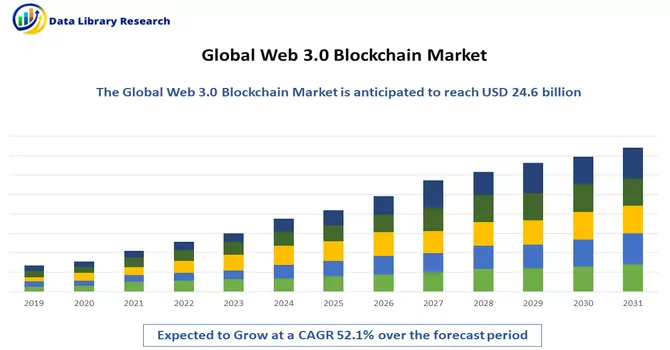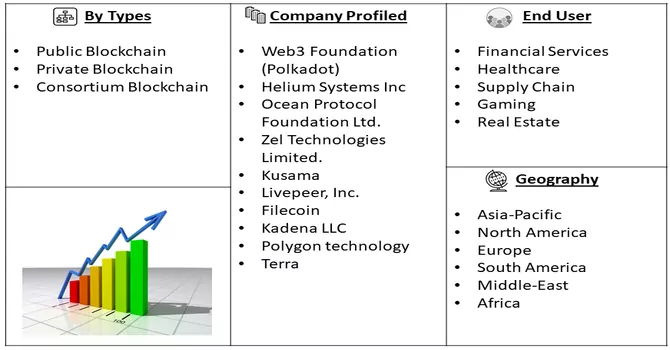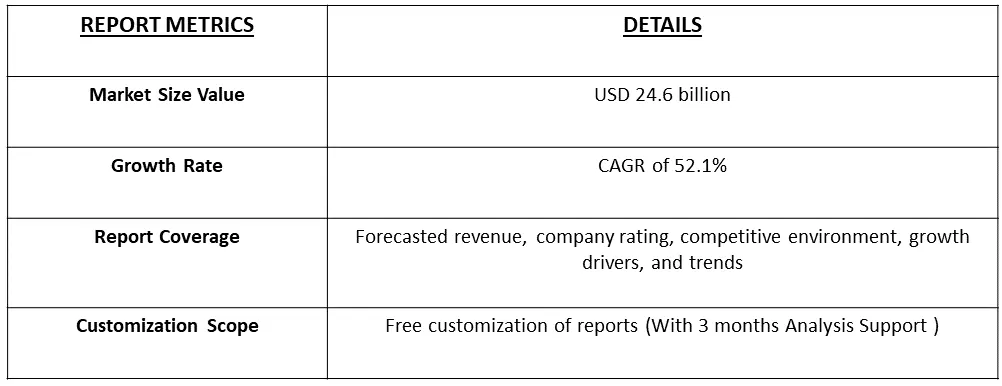The global Web 3.0 blockchain market size is currently valued at USD 24.6 billion in the year 2023, growing at a CAGR of 52.1% from 2024 to 2031.

Get Complete Analysis Of The Report - Download Free Sample PDF
Web 3.0 Blockchain represents the next phase of the World Wide Web, incorporating blockchain technology to create a more decentralized, interconnected, and user-centric Internet experience. In this paradigm, decentralization is a key focus, providing users with greater control and ownership of their data. The integration of blockchain brings features such as transparency, security, and smart contracts into the web ecosystem. Interoperability between various blockchain networks is emphasized, allowing seamless interaction. The use of tokens on these networks enables the representation of ownership and facilitates transactions. As an evolving concept, Web 3.0 Blockchain envisions a shift towards a more secure, transparent, and automated online environment, with ongoing developments shaping its implementation and impact on the internet landscape. For the latest and most accurate information, reference to current sources and industry updates is recommended.
The growth of the Web 3.0 Blockchain market is propelled by several key factors. A notable driver is the increasing demand for a decentralized internet infrastructure, offering users greater control over their data and interactions. Blockchain's enhanced security features address rising cybersecurity concerns, attracting industries seeking a more secure online environment. The integration of smart contracts streamlines processes and eliminates intermediaries, contributing to the efficiency gains that drive the adoption of Web 3.0. Interoperability, the seamless interaction between diverse blockchain networks, is another crucial factor supporting market growth. Tokenization trends, where tokens represent assets and enable new economic models, add tangible value to the Web 3.0 ecosystem. The growing emphasis on data ownership and privacy, coupled with continuous blockchain innovations and research, further fuel the expansion of Web 3.0 Blockchain solutions. Additionally, the rise of decentralized finance (DeFi) contributes to the market's growth, as the financial industry explores decentralized technologies aligned with the principles of Web 3.0. Collectively, these factors position Web 3.0 Blockchain as a transformative force with increasing adoption across diverse industries.
The Web 3.0 Blockchain market is witnessing dynamic trends, with DeFi leading the way in offering decentralized financial services. NFTs are experiencing a surge in adoption, particularly in digital art and entertainment. Interoperability solutions are gaining prominence, fostering seamless communication between diverse blockchain networks. The rise of DAOs reflects a shift towards decentralized decision-making structures. Increased focus on privacy features addresses growing concerns about data security. Sustainability initiatives, promoting eco-friendly consensus mechanisms, are gaining traction. Web 3.0 protocols, emphasizing decentralized storage and identity management, contribute to an enhanced decentralized web. The market also sees integration with IoT and growing government and enterprise adoption across various use cases, accompanied by an evolving regulatory landscape.
Market Segmentation: The Web 3.0 BlockChain Market is Segmented by Blockchain Types (Public Blockchain, Private Blockchain and Consortium Blockchain), End User (Financial Services, Healthcare, Supply Chain, Gaming and Real Estate) and Geography (North America, Europe, Asia-Pacific, Middle East and Africa, and South America). The market provides the value (in USD million) for the above segments.

For Detailed Market Segmentation - Download Free Sample PDF
Market Drivers:
Growing Desire for a More Decentralized Internet
The increasing inclination toward a decentralized internet infrastructure is a driving force in the market's expansion, with Web 3.0 harnessing blockchain technology to empower users with enhanced control over their data and online engagements. In December 2023, LBank Labs, the investment division of the renowned LBank Exchange, unveiled a strategic collaboration with Hancom Frontis, a leading developer in the metaverse platform realm. This partnership marks a substantial stride in utilizing Hancom Frontis's metaverse platform and its proprietary on-chain data analysis technology for collaborative research and development within the Web 3.0 blockchain domain. The initiative underscores a commitment to exploring and advancing innovative solutions that align with the principles of a decentralized and user-centric digital landscape.
Ongoing Research and Development Activities in Blockchain
The persistent engagement in research and development endeavours within the blockchain domain serves as a catalyst for the expansion of the market. Unceasing innovation introduces novel functionalities, scalable solutions, and enhanced consensus mechanisms, nurturing the ongoing evolution of Web 3.0. This commitment to research not only propels the industry forward but also addresses the dynamic challenges and demands of the decentralized digital landscape. The iterative nature of these activities contributes to the refinement and augmentation of blockchain technologies, paving the way for a more sophisticated and adaptable Web 3.0 ecosystem. The pursuit of groundbreaking solutions reflects the industry's dedication to staying at the forefront of technological advancements and meeting the evolving needs of users and businesses in the decentralized paradigm.
In January 2024, The United Nations High Commissioner for Refugees (UNHCR) is actively investigating the potential of blockchain technology to enhance the delivery of aid to individuals displaced by conflicts in war-torn regions. During a panel discussion organized by Decentral House in Switzerland, Carmen Hett, the Treasurer of UNHCR's Division of Financial and Administrative Management, revealed the agency's commitment to developing a blockchain-based digital ID system. In attendance were various global agencies, including the International Telecommunication Union (ITU) and the World Trade Organization (WTO). The panel participants collectively brainstormed and exchanged ideas on how to integrate blockchain into their existing operations, aiming to improve efficiency and transparency in the provision of humanitarian assistance. This move underscores the UNHCR's proactive approach in leveraging innovative technologies to address the challenges faced by refugees and displaced populations, signalling a potential transformative shift in the way aid is delivered and managed in crisis situations. Thus, such developments are driving the growth.
Market Restraints:
Regulatory Uncertainty and Scalability Issues
Uncertainty stemming from the absence of well-defined and consistent regulations across different regions poses a significant hurdle to the widespread adoption of blockchain. The lack of clear regulatory frameworks introduces ambiguity, hindering the smooth development and implementation of blockchain solutions. In addition to regulatory challenges, scalability remains a persistent issue for numerous blockchain networks. As the volume of transactions escalates, certain blockchains encounter challenges related to performance, resulting in slower transaction processing times and elevated transaction fees. These scalability concerns not only impact the efficiency of blockchain systems but also underscore the need for innovative solutions to handle the growing demand and ensure the scalability of blockchain technology in diverse applications.
The market is anticipated to experience favourable outcomes from the ongoing COVID-19 pandemic. With the persistent nature of the pandemic, there has been a notable surge in online shopping on e-commerce platforms, accompanied by an increased frequency of online payments. This trend has led to a heightened adoption of Web 3.0 blockchain technology in online payment processes. The utilization of blockchain in this context is particularly advantageous, enabling faster transactions and enhancing overall security. Additionally, the industry's growth is further propelled by the increasing acceptance of blockchain technology applications, particularly in areas like smart contracts and cryptocurrencies. This multifaceted adoption of blockchain technologies is poised to contribute significantly to the expansion and development of the market landscape.
Segmental Analysis:
Consortium Blockchain Segment is Expected to Witness Significant Growth Over The Forecast Period
Consortium Blockchain, within the context of the Web 3.0 Blockchain market, represents a specific category of blockchain networks characterized by a semi-decentralized structure. Unlike fully public blockchains where anyone can participate, and private blockchains restricted to a single entity, consortium blockchains involve a group of organizations or entities forming a consensus mechanism for validating transactions and maintaining the blockchain network. This model offers a balance between decentralization and control, making it particularly appealing for collaborative efforts in industries where multiple parties need to share information securely and transparently. In the evolving landscape of the Web 3.0 Blockchain market, consortium blockchains play a pivotal role in fostering collaboration among diverse entities while maintaining a level of trust and efficiency. These blockchains find applications in sectors such as supply chain management, finance, and healthcare, where stakeholders collaborate on a shared ledger for enhanced transparency and streamlined operations. The consortium model aligns with the principles of Web 3.0, emphasizing interoperability, user-centric experiences, and decentralized governance. As the Web 3.0 Blockchain market continues to mature, consortium blockchains contribute to breaking down silos between organizations, enabling secure data sharing and fostering innovative collaborations. The emphasis on efficient, decentralized, and interoperable solutions within the Web 3.0 framework aligns with the inherent characteristics of consortium blockchains, making them a significant component in shaping the future of blockchain technology and its applications.
Supply Chain Segment is Expected to Witness Significant Growth Over The Forecast Period
In the Web 3.0 Blockchain market, the incorporation of blockchain technology into supply chain management signifies a revolutionary shift, aligning with the decentralized and transparent principles of Web 3.0. Blockchain's tamper-resistant ledger ensures secure and real-time recording of transactions across the entire supply network, mitigating issues of fraud and inefficiencies. This collaborative and user-centric approach enhances visibility, reduces costs, and fosters trust among supply chain stakeholders. Web 3.0's emphasis on interoperability proves instrumental in facilitating seamless communication and data exchange among diverse participants in the supply chain, ultimately contributing to a more resilient, transparent, and optimized ecosystem. As the Web 3.0 Blockchain market advances, the transformative impact on supply chain management underscores the potential for innovative solutions that align with the evolving needs of modern industries. Thus, owing to such advantages, the segment is expected to witness significant growth over the forecast period.
North America Region is Expected to Witness Significant Growth Over The Forecast Period
North America emerges as a pivotal hub for innovation, adoption, and advancement. The region, encompassing the United States and Canada, witnesses a dynamic landscape where blockchain technology aligns with the principles of Web 3.0, emphasizing decentralization, transparency, and enhanced user experiences. The entrepreneurial spirit and robust technological infrastructure in North America foster the development of blockchain applications across various sectors. With a significant presence of blockchain startups, established tech giants, and a supportive regulatory environment, North America becomes a focal point for pioneering projects that leverage the transformative capabilities of Web 3.0. Industries such as finance, healthcare, and supply chain management in the region increasingly integrate blockchain solutions to enhance operational efficiency, data security, and interoperability. As the Web 3.0 Blockchain market continues to evolve, North America stands at the forefront, driving innovation and shaping the trajectory of decentralized technologies in a global context.
In January 2024, Bullet Blockchain, Inc. (OTC: BULT), a trailblazing software development and SaaS company specializing in blockchain and Bitcoin ATM technologies, is excited to declare a notable achievement with the successful acquisition of a network comprising 40 Bitcoin ATMs situated in South Florida. This strategic move marks a significant step forward in BULT's planned deployment and branding initiatives. The acquisition forms part of a broader expansion strategy, underscoring BULT's commitment to innovation and its prominent role in the swiftly evolving digital currency sphere. This development positions BULT at the forefront of the industry, showcasing its dedication to staying ahead and shaping the landscape of blockchain and Bitcoin ATM technologies. Thus, such developments are expected to boost the growth of the studied market over the forecast period.

Major market players actively pursue strategies such as expanding their production capabilities, engaging in mergers and acquisitions, and conducting research and development initiatives to maintain a competitive edge in the industry. This involves increasing their capacity for manufacturing, acquiring other companies or merging with them to strengthen their market position, and investing in innovative research and development efforts. These strategic moves are crucial for staying ahead of competitors, enhancing market share, and ensuring sustained growth in the dynamic business environment. The commitment to these initiatives underscores the players' proactive approach in adapting to market trends, meeting evolving customer demands, and securing a prominent position in the competitive landscape. List of Key Players in the Web 3.0 Blockchain Market
Recent Development:
1) In January 2024, aelf is taking a significant stride in advancing cross-chain interoperability through a strategic collaboration with ChainsAtlas. Leveraging ChainsAtlas' pioneering virtualization technology, aelf aims to facilitate the seamless migration and integration of decentralized applications (dApps) from various blockchains into the aelf blockchain, irrespective of the smart contract specifications of these dApps. This partnership signifies a noteworthy move towards establishing a globally interconnected and streamlined blockchain ecosystem, dismantling the barriers that traditionally separate different blockchains. By embracing innovative solutions for cross-chain compatibility, aelf and ChainsAtlas are contributing to the creation of a more integrated and efficient landscape for blockchain technologies.
2) In July 2022, KiwiTech, an innovation ecosystem company, introduced its Web 3.0 Center of Excellence service aimed at fostering the development of next-generation blockchain innovations for startups. This service launch is anticipated to generate promising avenues for market growth in the foreseeable future. The initiative underscores KiwiTech's commitment to providing a supportive environment for emerging businesses in the blockchain space, paving the way for innovative projects and solutions. The introduction of the Web 3.0 Center of Excellence not only aligns with the industry's dynamic landscape but also signifies the recognition of the transformative potential of blockchain technologies. As startups engage with this service, the market is poised to witness an influx of creative ideas and pioneering developments that could shape the future of blockchain innovation.
Q1. What is the current Web 3.0 Blockchain Market size?
The global Web 3.0 blockchain market size is currently valued at USD 24.6 billion.
Q2. At what CAGR is the Web 3.0 Blockchain market projected to grow within the forecast period?
Web 3.0 Blockchain Market is growing at a CAGR of 52.1% over the forecast period.
Q3. What are the factors driving the Web 3.0 Blockchain market?
Key factors that are driving the growth include the Growing Desire for a More Decentralized Internet and Ongoing Research and Development Activities in Blockchain.
Q4. Which region has the largest share of the Web 3.0 Blockchain market? What are the largest region's market size and growth rate?
North America has the largest share of the market. For detailed insights on the largest region's market size and growth rate request a sample here.
Data Library Research are conducted by industry experts who offer insight on industry structure, market segmentations technology assessment and competitive landscape (CL), and penetration, as well as on emerging trends. Their analysis is based on primary interviews (~ 80%) and secondary research (~ 20%) as well as years of professional expertise in their respective industries. Adding to this, by analysing historical trends and current market positions, our analysts predict where the market will be headed for the next five years. Furthermore, the varying trends of segment & categories geographically presented are also studied and the estimated based on the primary & secondary research.
In this particular report from the supply side Data Library Research has conducted primary surveys (interviews) with the key level executives (VP, CEO’s, Marketing Director, Business Development Manager and SOFT) of the companies that active & prominent as well as the midsized organization
FIGURE 1: DLR RESEARH PROCESS

Extensive primary research was conducted to gain a deeper insight of the market and industry performance. The analysis is based on both primary and secondary research as well as years of professional expertise in the respective industries.
In addition to analysing current and historical trends, our analysts predict where the market is headed over the next five years.
It varies by segment for these categories geographically presented in the list of market tables. Speaking about this particular report we have conducted primary surveys (interviews) with the key level executives (VP, CEO’s, Marketing Director, Business Development Manager and many more) of the major players active in the market.
Secondary ResearchSecondary research was mainly used to collect and identify information useful for the extensive, technical, market-oriented, and Friend’s study of the Global Extra Neutral Alcohol. It was also used to obtain key information about major players, market classification and segmentation according to the industry trends, geographical markets, and developments related to the market and technology perspectives. For this study, analysts have gathered information from various credible sources, such as annual reports, sec filings, journals, white papers, SOFT presentations, and company web sites.
Market Size EstimationBoth, top-down and bottom-up approaches were used to estimate and validate the size of the Global market and to estimate the size of various other dependent submarkets in the overall Extra Neutral Alcohol. The key players in the market were identified through secondary research and their market contributions in the respective geographies were determined through primary and secondary research.
Forecast Model
